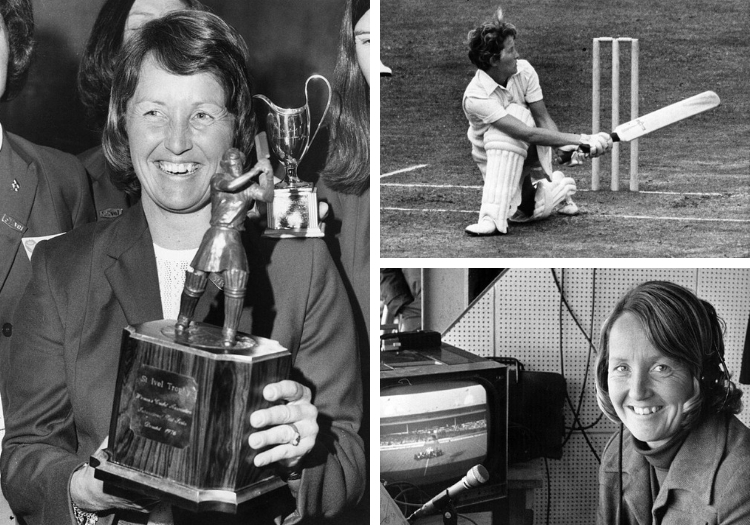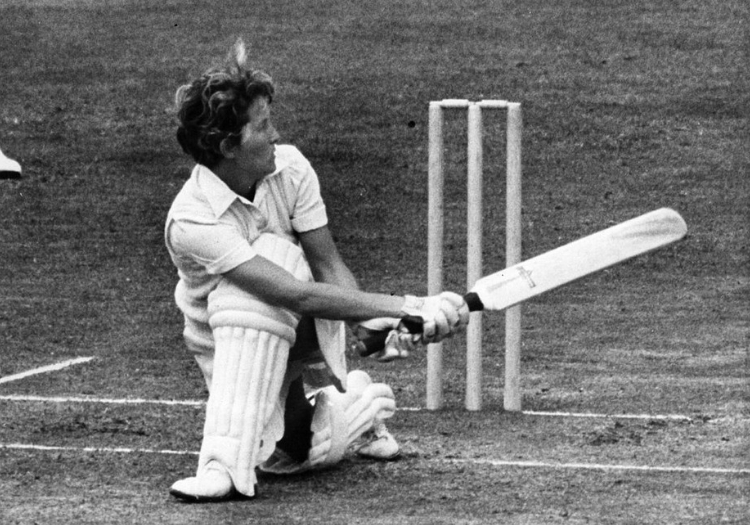"What set Rachael apart was her relentless drive and energy on and off the field and the chutzpah with which she charmed powerful supporters."

Sally Jones was the BBC’s first woman sports presenter in the late 1980s and now writes widely on sport, education and news. She won five Blues at Oxford including a half-Blue for cricket and captained the university at tennis, netball and squash. She skippered Warwickshire Tennis for a decade and was World Real Tennis champion in the 1990s.
My first meeting with cricketing pioneer Rachael Heyhoe Flint shocked me rigid.
I had agreed to give a talk at a Lady Taverners’ fundraising lunch she was organising, partly, it must be said, for the chance to meet one of my sporting heroines, whose exploits I had followed since she led England to victory at the inaugural Women’s World Cup in 1973.
I imagined a rather crisp, forceful lady, the soul of propriety, like a cross between the school games captain and Mary Poppins. In fact she greeted me like a long-lost friend, a cheeky smile lighting up her vivid face. We swapped anecdotes about our shared experience of trying, as women, to find a foothold in sports media, then an overwhelmingly male bastion. Finally, to my astonishment she told me an unprintably filthy but hilarious joke to which the punchline was ‘personhole cover’. My Mary Poppins-style preconceptions were instantly swept away.
Suddenly it all fell into place: how that potent mixture of raw talent, mischief and self-belief had taken her to the top, first of hockey (she played goalkeeper for England in the 1960s) then of cricket, in which she transformed the women’s game from a minor footnote to a mainstream sport. I saw in a heartbeat her appeal as an irreverent after-dinner speaker and how she had managed to get everyone on side, from the stuffed shirts of the sporting Establishment to the young girls she inspired to believe that cricket was not just a game for the boys.

Rachael Heyhoe (as she was then) sweeps against New Zealand at The Oval in 1966
Heyhoe’s route to stardom both as a trailblazing cricketer and a brilliant promoter of the women’s game began decades earlier during her childhood in Wolverhampton, when she emerged as a precociously gifted all-round sportswoman. She later represented Staffordshire at hockey, squash and golf and became a single figure handicap golfer.
A school trip to Edgbaston to see the New Zealand women’s team in 1954 sparked her interest in cricket. She helped form a school team and became its star batswoman, then progressed to the Staffordshire XI. She received her England call-up to tour South Africa in 1960/61, scoring her first half-century in the second Test at Johannesburg. Women’s tours were rare in that era, and England’s next outing was the visit of Australia and New Zealand in 1963. By the end of the summer, Heyhoe, a PE teacher in her day job, had become captain and scored her first century thanks to teeth-clenched determination and a fluent, accomplished style.
In the mid-’60s, she gave up teaching for journalism on the Wolverhampton Express and Star and later the Daily Telegraph, a crucial element in her promotion of the fledgling women’s game as she quickly understood the media’s need for a snappy headline and the ‘Man Bites Dog’ story guaranteeing column inches even to a minority sport. Her writing also boosted her own profile, making her one of the most recognisable sporting personalities in Britain.
"When the vote to allow women to join MCC passed, she ran to the Grace Gate where the film crews descended on her"
For me, what set Rachael apart was her relentless drive and energy on and off the field and the chutzpah with which she charmed powerful supporters. While captaining the cash-strapped England side on tour against Australia and New Zealand in 1968/69, she was also the main fundraiser and cheerleader for the tour. Enlisting the spending power of the rich Wolverhampton-based businessman and philanthropist Sir Jack Hayward, she organised the first cricket World Cup (in either gender) in 1973, and led England to victory. She remained unfazed by the many setbacks she faced and treated entrenched male chauvinism with sunny disdain.
When Len Hutton scathingly declared: “A woman trying to play cricket is like a man trying to knit”, she let her batting do the talking. The famously gaffe-prone Duke of Edinburgh asked her if the players wore coconut shells in their bras for protection. Typically she roared with laughter rather than taking offence.
In a career littered with firsts, her 179 at The Oval in 1976 against Australia, the highest score a woman had then achieved, was a standout moment. She batted for eight and a half hours to earn a draw that saved the series. Another came in 1999 when she overturned 212 years of all-male tradition to become one of the first 10 female Honorary Life Members elected to MCC.

Batting at The Oval
“She’d lobbed a hand-grenade into the male establishment,” recalled her son Ben, “by putting in an application form as ‘R Flint’ – omitting the Mrs. They realised too late. We were sitting in the Lord’s Tavern – they didn’t let her into the EGM! - and when the news broke, some of the media rushed out to tell her that the vote to allow women to join MCC had been passed. She leapt over the fence like a 20-year-old and ran to the Grace Gate where the film crews descended on her. I remember fielding her phone from behind her back as she was on air; it was red-hot for hours.”
Ben, himself a keen cricketer, delighted his mother by playing for Staffordshire juniors and the Malvern College 1st XI, but realising the pressure he might feel having the England captain on the boundary, she always watched discreetly from behind a tree. She was also elected to the Malvern College Council and after her death from cancer in 2017, the family established a prestigious girls’ cricket scholarship at the college in her name. Those of us who were acquainted with her know just how delighted she would have been to see more youngsters given the chance to fulfil their potential at the game she loved.
She also served on the board of directors of Wolverhampton Wanderers from 1997 to 2003, with Hayward as chairman. She had watched them win the league three times in the 1950s.
Perhaps the major beneficiary of her extraordinary life and career however, is the international game. These days England’s women are salaried professionals, playing around the world for much of the year, with live coverage on TV and radio making the top stars household names. They enjoy generous sponsorship deals plus similar kit and coaching to their male counterparts and unsurprisingly the standard of top-class women’s cricket at all age-groups is going from strength to strength. To me, this is her greatest legacy
This article was published in the February edition of The Cricketer - the home of the best cricket analysis and commentary, covering the international, county, women's and amateur game
Save 30% when you subscribe to The Cricketer’s print & digital bundle. £35 for 12 issues